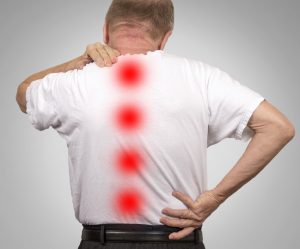
Senior elderly man with stenosis of the spine
Age can bring about a condition known as stenosis of the spine, where your neck or lower back become narrowed, occasionally putting pressure on the spinal cord or nerves. Sometimes the pressure will result in pain or numbness in legs, back, neck and shoulders, depending on which nerves are affected. It can cause a loss of coordination, numbed sensations in arms and legs, and your bladder or bowel functions may be altered. This condition is most commonly found in patients over 50 years of age, usually associated with osteoarthritis, when the joints between vertebrae deteriorate, causing bony growths known as bone spurs, which also cause narrowing of the spinal column.
Spinal stenosis in the neck can cause numbness, tingling or weakness in the corresponding extremity. Clumsiness is often a symptom, so tell you doctor if you notice this. Neck and shoulder pain can happen too if your nerves are compressed, but in some cases, the condition causes no symptoms at all. Lower back pain might be caused by lower back spinal stenosis, accompanied by cramps after walking or standing for long stretches of time.
Article Con’t…
In severe cases, doctors may advise surgical intervention, which makes additional room in the spinal column for the cord and nerves. This could be recommended in the case of Paget’s disease of the bone, when the body creates new bone at an accelerated rate. The disease causes bones to be weak and more apt to fracture, and can create abnormally large bones; if this occurs in the spine, it can narrow the space in the spinal canal, and cause the attendant spinal stenosis symptoms. Surgery is recommended as well when the spine develops tumors, which can cause compression of the spinal cord and nerve roots, resulting in pain, swelling, tingling, numbness and loss of limb coordination.
In the event of severe cervical spinal stenosis, bladder and bowel control can be compromised, in which case surgery is also recommended. Weakness or partial paralysis is also a problem for surgery to solve. Another uncommon but very serious complication is called cauda equina syndrome, where the nerve root bundle at the base of the spinal cord becomes compressed. This may result in numbness or paralysis, and emergency surgery will be recommended to ease the symptoms.
Age plays a role in the development of stenosis of the spine; those over 50 are the most prone to its onset. There are birth defects that can cause a small spinal canal, which increase the chances that spinal stenosis will develop. Another complication of an aging spine is that of disk degeneration, when the fluids and tissue between the vertebrae flatten out and bulge between the discs. Pressure comes from a thickened fibrous coating over the disk that can tear, allowing the fluid in the disks to bulge, and press against the spinal cord and nerves. Another condition involves thickening of the ligaments that hold the disks together; they can bulge into the spinal canal, narrowing the spinal cord and compressing nerves.



